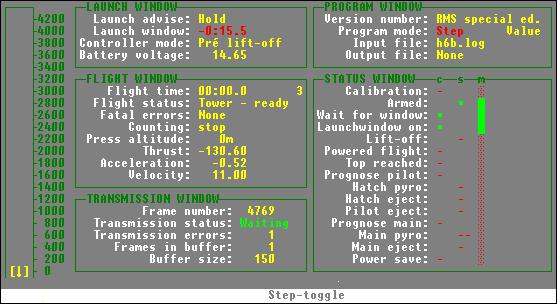The H6 rocket
|
|
The development of the H6 rocket in the years 1988 to 1994. The rocket was designed to comply with the requirement to be as light as possible. Achieving this goal enabled us to fly a completely equipped rocket faster than the speed of sound (Mach 1). The rocket was equipped with an advanced on-board computer, which collected the measurement data from several instruments and sensors and was able to show this in real-time on a monitor at the ground control station. Besides real-time data transmission, the data was also recorded in the so-called IRM (Impact Resistant Module). As a consequence of this method of data acquisition, the on-board computer itself was able to indicate what the best moment for launch would be. The recorded sensor data resulting from the H6b flight was checked later on with extensive simulation software, which provided us with insight into the physics of such a rocket flight. For the H6, a lot of systems and concepts were developed, which could be used later in the H7 rocket. An important disadvantage of the rocket turned out to be the complexity of the (software of the) on-board computer. This eventually resulted in the search for more simple solutions, like the Finite State Machine (FSM). |
Theoretically, this construction is an ideal construction for several reasons. First, the rocket is much stiffer for buckling, bending and torsion than a rocket with an internal load-carrying frame (at the same structural mass). The tube can therefore be very thin. Furthermore, the internal structures, e.g. the sub-structure for the electronics, can be designed with minimum mass since they don't have to carry large loads.
Just as important as the above, is the principle that the load exerted on a rocket will follow the shortest route possible. This means that unnecessary structural mass can be left out. In the H6 rocket, all non-structural parts, such as the motor, the attachment for the parachute cords and the de-blocking device, are therefore mounted on one of the joints between the compartments.
To the right of the figure below you'll find links to some of the subjects which give an impression of what is relevant for the design and the launch of the H6 rocket.
 |
||||
|
|
Parachutes | |||
|
|
Pyrotechnical devices | |||
|
|
Skin | |||
|
|
Substructure | |||
|
| Electronics | |||
|
| Downlink | |||
|
|
Motor | |||
|
|
Boat tail with antenna |
Beware: This program is not fully windows compatible and can only be started using an open MS-DOS window. Put the RMSse an data files in the same directory. Open a MS-DOS window. and make the directory active (CD-command). Start the program.

52,1KB
Fortunately, help came from photographs taken during the launch. From the photographs it could be deduced that a sudden wind gust had changed the flight direction of the H6 rocket. We now had the task to try to determine which trajectory had been followed by the H6 in order to find the impact location. Using simulation software, the wind profile of that day and the data recorded by the RMS, we were finally able to predict the impact point. The rocket was later recovered from the crash site which turned out to be within 40 meters of the predicted location. The whole trajectory analysis had cost us about 100 man-days of work.